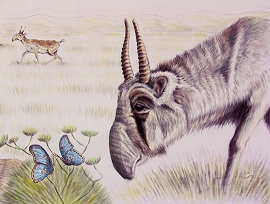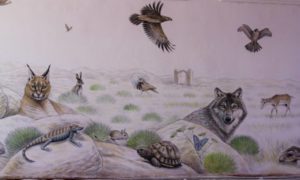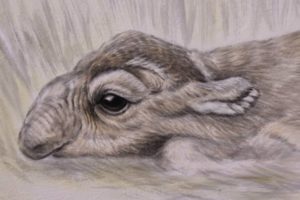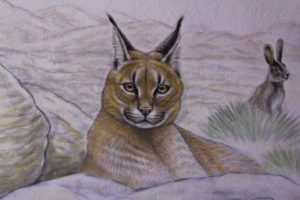This spring, a completely new approach to Saiga conservation has been trialled in Uzbekistan. British wildlife artist Rory McCann travelled to Karakalpakstan, in Uzbekistan, to paint a mural depicting the wildlife of the steppe habitat. Uzbek student Olga Esipova assisted Rory with communications and painting. The idea was to improve attitudes towards the conservation of the Saiga through creation of a terrific mural painting with the participation of local children. The mural was painted in one of regional schools, where lots of students were involved. This project was made possible by the generous support of the Coins for change programme, Disney Canada – which funds vital conservation work all over the world.
“The Saiga mural is truly magnificent in every sense of this word. All our school appreciates your wonderful work. Rory is an absolutely amazing artist; his paintings must be inspired by his soul! Even though Olga is only at the beginning of her way, she has already achieved a lot. I’m sure that soon she will reach the top! Thank you both for your diligence and that you please people with your art. Your painting is worth more than words!”
– Aisulu Dzholdasbayeva, school 37, Nukus
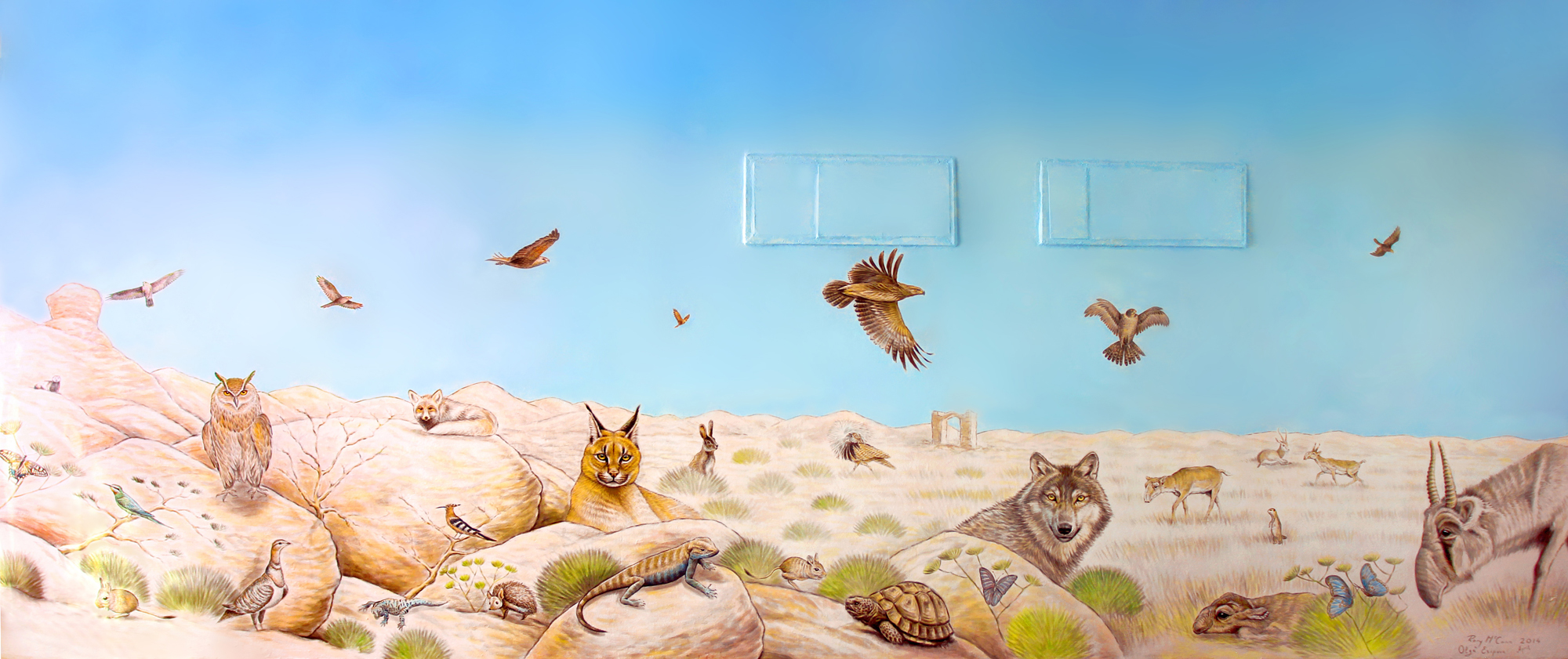
Rory McCann: I am a UK-based wildlife artist, working mainly on large scale mural projects in schools. I have also worked as an artist in Australia, the Seychelles, Oman, and Japan. Our objective in Uzbekistan was to work with local school children to paint a huge mural depicting the wildlife of the Steppe habitat. This, we hoped, would help to improve their attitudes towards local conservation efforts, especially those focussed on the Saiga.
The project was a success before it had even really started. Our aim was to use the mural painting to engage the children and get them interested in their local wildlife and conservation efforts. This wasn’t exactly an uphill struggle; the children came to check on our progress regularly and in droves. They had an insatiable curiosity to know more about the wider world but would also listen intently while we told them about their own wildlife treasures. They wanted to take photo after photo, have small scraps of paper signed, but more than anything, they wanted to ask questions. It struck me that because of the incredible enthusiasm and curiosity that children have at this age, that it’s the perfect time to get them interested in biodiversity and conservation. This will then hopefully lead on to them being environmentally conscious adults, helping the environment wherever they are able.
We had 8 days of painting. We started with drawing out the key species of the steppe habitat – with the Saiga as the main focus. At this stage, we had various children painting alongside us. We were able to coordinate their painting efforts while also dealing with the ongoing flood of questions from our spectators. In addition to painting with an ever-changing assortment of spectators, we were accompanied by swifts circling the room (and occasionally adding their own splash of colour to the wall), and classes of children who were being taught traditional dances in the same room.
 I leave behind me a mural that will hopefully act as a source of inspiration and a tool for education for many years to come; instilling positive attitudes towards wildlife and conservation in many thousands of young people. I take with me a great many happy memories, of painting the beautiful wildlife of the Uzbek steppe, of unexpectedly being an integral part of a local wedding ceremony, and most of all – of interacting with the wonderful school children of Nukus. The Saiga antelopes’ hopes for survival depend, in some part, upon them. My hopes are high.
I leave behind me a mural that will hopefully act as a source of inspiration and a tool for education for many years to come; instilling positive attitudes towards wildlife and conservation in many thousands of young people. I take with me a great many happy memories, of painting the beautiful wildlife of the Uzbek steppe, of unexpectedly being an integral part of a local wedding ceremony, and most of all – of interacting with the wonderful school children of Nukus. The Saiga antelopes’ hopes for survival depend, in some part, upon them. My hopes are high.
This was a wonderful project to be a part of. I have to thank E.J. Milner-Gulland for sowing the seed and helping it grow; Carlyn Samuel, for working out the evidently complicated logistics; Elena Bykova and Alexander Esipov for their amazing hospitality and company; Olga Esipova for her superb painting, inexhaustible energy when translating and great company; and the staff and children at the school # 37 in Nukus, for their kindness, curiosity, enthusiasm and smiles.
Olga Esipova: I am an 18 years old student of English philology from Uzbekistan. Over the last couple of years I have been volunteering for SCA because the wildlife of my region amazes me and I believe that my work helps to conserve it for the sake of future generations. Meanwhile, I am interested in art as well and have some experience in painting. No wonder that I was very enthusiastic and got really exited once I was offered to participate in the mural project in Nukus.
 I remember the moment when we’d just arrived at the Nukus school. The school was much bigger than I expected – I was told that approximately two thousand students studied there. Everybody was surprised to see us and nobody seemed to know why a group of strangers suddenly came to the school. We wanted this project to have as big an impact as possible, which would not be achievable without children being involved. That is why, instead of starting a painting straight away, the first thing we did was a short presentation where we introduced our project and ourselves. It worked perfectly. The children were intrigued and keen to learn more about biodiversity. They wanted to be engaged and asked bunches of questions!
I remember the moment when we’d just arrived at the Nukus school. The school was much bigger than I expected – I was told that approximately two thousand students studied there. Everybody was surprised to see us and nobody seemed to know why a group of strangers suddenly came to the school. We wanted this project to have as big an impact as possible, which would not be achievable without children being involved. That is why, instead of starting a painting straight away, the first thing we did was a short presentation where we introduced our project and ourselves. It worked perfectly. The children were intrigued and keen to learn more about biodiversity. They wanted to be engaged and asked bunches of questions!
There was no time to lose though. Quite soon we started drawing and the day after few students joined us. I had never painted on a rough bare wall before and neither had the children. It felt a bit uncomfortable at the beginning but the more we painted the more we enjoyed painting. Also, more and more school children, their teachers, and parents came to help us or just to watch us drawing animals. They learned something new about wildlife and conservation each time they visited us. The week passed unbelievably quickly and there was our final day in the school. We about ran out of time and had to work really hard at the end but still managed to finish the painting.
The whole project turned out as a total success. We could see happy children proud to have such a beautiful mural in their school and be a part of it. The painting inspired an interest in art and conservation as well as a love for nature. The ability to see changes in children’s minds and understand that the project has already made a difference was the greatest reward for me. I believe that this successful experience can be transferred to other Saiga places in order to improve responsibility and attitudes towards Saiga’s among the local people.
I would like to thank my parents – Elena Bykova and Alexander Esipov for bringing me into the project and their tireless support all the way through; Rory McCann for being both a great teacher and a good friend, his contagious enthusiasm for painting and wonderful ukulele playing; the children and staff of school № 37 for making our experience so pleasant and their help that is impossible to overestimate.
See a short clip of how the mural was made at:

